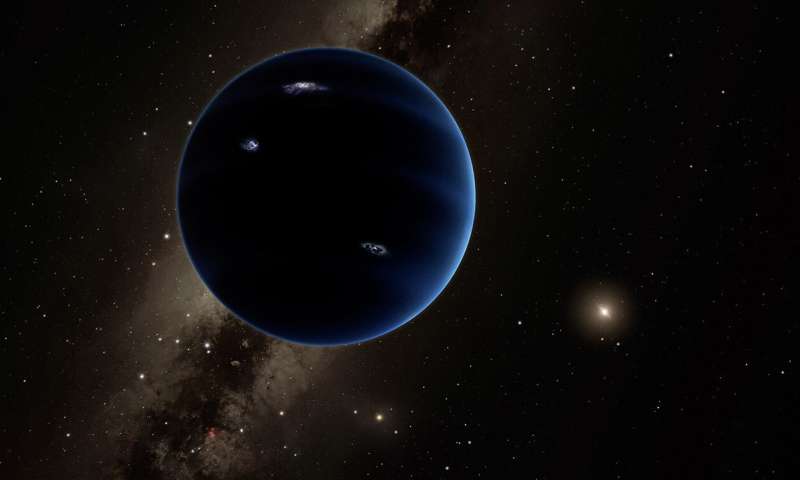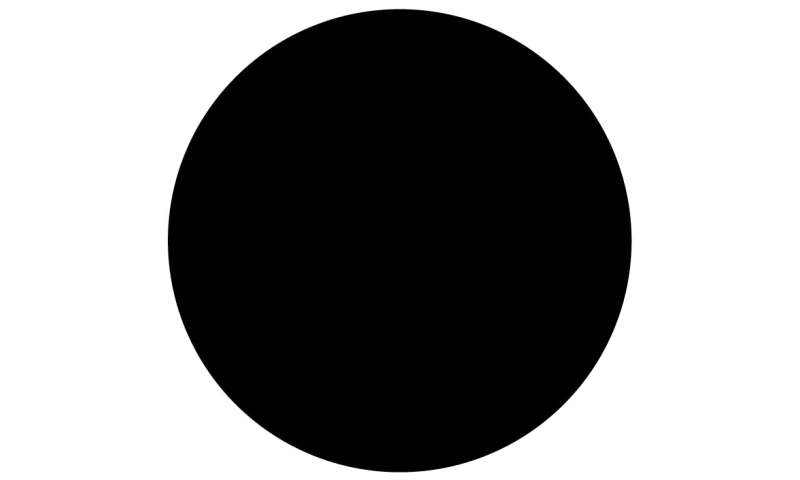
For several years, astronomers and cosmologists have theorized about the existence of an additional planet with a mass 10 times greater than that of Earth, situated in the outermost regions of the solar system. This hypothetical planet, dubbed Planet 9, could be the source of gravitational effects that would explain the unusual patterns in the orbits of trans-Neptunian objects (TNOs) highlighted by existing cosmological data. TNOs are celestial bodies that orbit the sun and are located beyond Neptune.
Building on studies conducted over the past few years, Jakub Scholtz and James Unwin, two researchers at Durham University and the University of Illinois at Chicago, have recently carried out an investigation exploring the possibility that Planet 9 is a primordial black hole. Their paper, published in Physical Review Letters, hypothesizes that the anomalous orbits of TNOs and an excess in microlensing events observed in the 5-year Optical Gravitational Lensing Experiment (OGLE) dataset could be simultaneously explained by the existence of a specific population of astrophysical bodies (one of which would be Planet 9). More specifically, it introduces the idea that Planet 9 and the rest of these bodies may be primordial black holes (PBHs).
"Our work started when James and his wife Laura went to the Chicago planetarium and saw a short documentary about Planet 9," Jakub Scholtz, one of the researchers who carried out the study, told Phys.org. "It must have captured James' attention, because he called me the next day and we started figuring out whether there is any other object that could be out there mimicking a planet. We came up with a number of fun scenarios: Bose stars, ultra-compact dark matter halos, primordial black holes—and several other possibilities."
A few months after they started exploring hypotheses about the nature of Planet 9, another research team at the University of Tokyo reanalyzed data collected as part of the OGLE experiment. OGLE is a research project carried out at the University of Warsaw that entailed capturing images of the sky using advanced telescopes over long periods of time.
The reanalysis of the OGLE dataset tentatively pointed to the existence of a population of PBHs with a mass similar to what astronomers predicted the mass of Planet 9 would be. When Scholtz and Unwin learned about these tentative findings, they started specifically considering the possibility that Planet 9 may, in fact, be a primordial black hole.

"The final pieces really came together when we realized that the dark matter haloes that surround primordial black holes would be a way to observe Planet 9 if it was a black hole, because of the X-ray/gamma-ray signal it gives off," Scholtz said. "In some sense, the objective of our study really was to convey the message that the idea of a primordial black holes orbiting the sun is not as absurd as it may seem, and that maybe we should be paying greater attention."
The hypothesis that the unusual orbits of TNOs observed in past cosmological data could be explained by the existence of an additional planet (Planet 9), has already been explored by several researchers, including a team at the California Institute of Technology led by Michael Brown and Konstantin Batygin. The team at the University of Tokyo who reanalyzed the OGLE dataset, on the other hand, was the first to introduce the idea that the excess in microlensing events observed within the OGLE data could be evidence of the existence of a population of PBHs.
Essentially, the study by Scholtz and Unwin connects these two hypotheses, suggesting that the long-theorized extra planet could, in fact, be a black hole that belongs to the population of PBHs proposed by Nikura and her colleagues at the University of Tokyo. In addition, the researchers showed that one of the previously theorized scenarios for the origin of Planet 9, known as the "capture of a free-floating planet," is just as likely when considered as a scenario involving the capture of a PBH from the population highlighted by the team in Japan.
"I think that our study has two key important outcomes," Scholtz said. "Firstly, we managed to inspire other scientists, who were initially skeptical (as they should be) about this scenario, and some very fun ideas have come out of it. For instance, Edward Witten suggested that we probe the existence of Planet 9 through small space probes based on the Starshot program, and Loeb et al. pointed out that a population of primordial black holes would cause occasional flashes when they encounter material on their orbit."
The recent paper by Scholtz and Unwin introduces a new, fascinating hypothesis about the nature of what has so far been referred to as Planet 9. This hypothesis could be explored further or tested in new research studies. In addition, the two researchers have started closely looking at moving gamma-ray and X-ray sources in the sky, a subject that has so far been largely ignored, despite the vast amount of available data that would allow researchers to study them.
"Our future research will mainly be focusing on exploring various existing datasets and looking for evidence (or lack thereof) of moving sources in the sky," Scholtz said. "We have identified a very promising method that could help us to see a moving source, as long as we detect just about 10 source photons a year with the FERMI-large area telescope (in the GeV range)."
Evidence for a distant giant planet in the solar system. The Astronomical Journal (2020). DOI: 10.3847/0004-6256/151/2/22.
The planet nine hypothesis. Physics Reports (2020). DOI: 10.1016/j.physrep.2019.01.009.
Constraints on Earth-mass primordial black holes from OGLE 5-year microlensing events. Physical Review D (2020). DOI: 10.1103/PhysRevD.99.083503.
© 2020 Science X Network
Citation: Could Planet 9 be a primordial black hole? (2020, August 24) retrieved 24 August 2020 from https://phys.org/news/2020-08-planet-primordial-black-hole.html
This document is subject to copyright. Apart from any fair dealing for the purpose of private study or research, no part may be reproduced without the written permission. The content is provided for information purposes only.
https://phys.org/news/2020-08-planet-primordial-black-hole.html
2020-08-24 13:40:02Z
CAIiEAtCKuBOOpWddwT-IsbsKQQqGAgEKg8IACoHCAowpbDpAzCm_hww4PzGBg
Bagikan Berita Ini















0 Response to "Could Planet 9 be a primordial black hole? - Phys.org"
Post a Comment